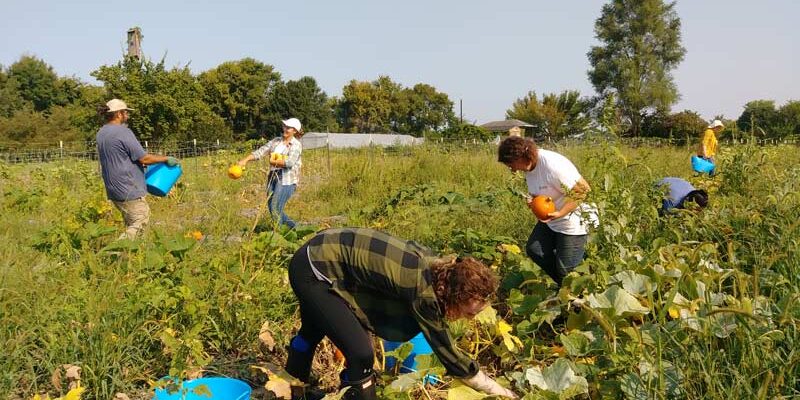Journals and Letters week 18: New Orleans to Indiana
[Today we are discussing “Journals and Letters” page 160 mid-page to page 168. Join us in reading a portion of Saint Mother Theodore’s writings every week in the coming year.]

How I love this part of the story! It’s packed with such insights into Mother Theodore’s heart and mind. Again, she shows us her astute observations of nature, her love and wonder at the dolphins [‘Any day you see a dolphin is a good day!’ I often say to visitors I’m guiding at our nearby state park overlooking the Pacific]. We see her intelligent perceptions about the processes by which the Delta Islands are created and her wonder at the “magnificent spectacle” of the sea of ships from all over the world. She even recognizes her old friend and protector, the Cincinnati, in which she made her first voyage to the United States. I, too, have spent months at a time at sea. And I know that feeling of recognizing the vessel that held you safe and the affection you can feel for such a thing.
Glory of nature
Like the writings in her first Journal, Mother Theodore again shows us that she can marvel at the work of humans as well as the glory of nature. That itself is a gift. Mother Theodore shows such compassion in her care of a dying man and his wife. She, who chafed a few years ago at being crowded together to sleep with strangers on the river boat, shares her small room for two days with this Protestant widow. She stays with her in her grief until she can “put her in the hands of a friend.”
New Orleans sickness
On arrival to the Ursuline sisters in New Orleans, the Providence Sisters’ first act is to go to the chapel and offer thanksgiving, just as they have done each time they have arrived at a destination. Mother Theodore’s thanksgiving for, and union with, the friends and benefactors left behind is expressed so beautifully. “For true hearts there is no separating ocean; or, rather, God is their ocean, in Whom they meet and are united.” Mother Theodore knows the desire to be One.
Next comes the illness. Mother Theodore has not spoken of troubles in this account. Indeed, she writes that the news she has from her sisters at the Woods is that all is well. But we know that Sister Basilide had written to her, accounting details of the troubles there. And no doubt that stress may have contributed to the fever that attacks her and leaves her in the care of the Ursulines for seven weeks while she was “burning with desire to join them all again.” I think it is very telling that Mother Theodore doesn’t mention in this Journal the grief the Bishop is causing the community back home.
And slaves

Then we come to the description of New Orleans and the well-known passage about Mother Theodore’s pain at seeing the slave market. She wishes she could purchase all the slaves at auction and set them free. Her statement at that time is one we must take to heart still today: “These Americans, so proud of their liberty, thus make game of the liberty of others.” No slave markets today, no. Yet that legacy is still so evident in the systemic racism that tells a lie about “liberty and justice for all.”
Indiana home
Finally, the steamer took Mother Theodore north and she exclaims, “With inexpressible joy I saw once more my Indiana.” MY Indiana! It was “no longer for me the land of exile; it was the portion of my inheritance, and in it I hope to dwell all the days of my life.” Well, I know that feeling, too. A Hoosier transplant for many decades to southern California, I feel that thrill of joy each time I return to MY Indiana, and especially to our beloved Woods where this story began and continues still today.
What about you?
I so look forward every week to the comments as well as the reflections on these pages. It is thought provoking to hear what touches others, so leave a comment!
Next week > page page 169 to page 180



Thank you, Jeannie, for your insights. As I read this week’s pages, I was struck also by her acute observations of nature as you described them. I believe that one of Mother Theodore’s many gifts bequeathed to us, is our being able to use these observations as a basis for meditation. As she describes “the fog had disappeared and we were lost in admiration of one of the fairest scenes of the world. The vast sea which we were on the point of quitting, the sea of another kind which we were about to enter…”, I experienced this being related to difficult times in my life. The “fog” of those times yielded to my clear vision of Providence’s presence with me and guided me on the continuation of my journey in peace and the reassurance of being accompanied .
One other thought …as Mother Theodore describes her prayerful gratitude for “… dear and generous friends beyond the sea who were so truly present to my thoughts and affections that I seemed actually in the midst of them” , she reminds me that there is a living bond among us when we choose to open our hearts to it. I find great comfort in believing this bond exists after death, also, and, as I pray in thanksgiving for the lives of family and friends who have been called home, we meet in God, are united and find ourselves together in God.
Jeannie:
I have heard MTG’s quote: For true hearts there is no separating ocean; or, rather, God is their ocean, in Whom they meet and are united,” many times but your comment after the quote that “Mother Theodore knows the desire to be One” really touched me. I had never thought of it that way. So as we continue our own journey as the Providence Community to move from I to we to ONE I am going to pray this quote and ask our very own Saint to give us this same desire to be ONE.
Hey, Jeannie. Here’s the deal. I loved the way you intertwined your experience on ships and on the ocean with MTG’s experiences. Made both experiences very first hand. I do wish you hadn’t pointed out or used the word “chafe” – I am currently chafing about, with, over, against lots of circumstances and I didn’t like being challenged to grow up, get over it. Take a lesson from MTG. It’s a great word, Jeannie. A wonderful reflection. Thank you.
Dear Denise – maybe I’ll send you some salve.
Very thoughtful of you, Jeannie. I’d prefer you remove all the things that I chafe against. Salve would be second best.
Jeannie, wonderful reflection and insights.
On page 161, Mother Theodore writes “At length we cast an anchor and the perils of the sea were over.” The word “anchor” called to mind a favorite passage of mine “We have this hope as an anchor for the soul, firm and secure.” (Hebrews 6:19). (Aside: On the campus of Hope College in Holland, Michigan, there is a huge anchor (weighing 9 tons in fact) that sits on the campus grounds reminding students of their school motto “Hope in God.”)
And so I reflect on a few images in this reading.and Mother Theodore’s comments.
The image of the anchor for hope.
The image of the ship, the Cincinnati: “The sight of it gave me those feelings of pleasure that one experiences again on seeing an old friend…”
The image of the Ursuline Sisters: “Oh, how compassionate, how universal, and beautiful is charity.”
The image of selling of slaves: “I would have wished to buy them all that I might say to them “Go! Bless Providence. You are free!”
The image of Indiana: “This land was no longer for me the land of exile: it was portion of my inheritance, and in it I hope to dwell all the days of my life.”
Mother Theodore takes all these images and goes deeper; she makes them meaningful, transformative. They are a conduit for her to God, to humanity, to earth. I would venture to say that through her writings on the meaning of all these images, it moved her from the I to we to One.
Thank you, Jeannie, for opening our Week 18 with Mother Theodore (I can’t believe it is already up to 18)! It is definitely packed with so many words from Mother Theodore that allows us to see more into her heart and mind.
And to you Cathy: What a wonderful reflection you provided. The idea of “anchor” as a stabilizer- as a way for hope. The scripture passage you included was beautiful: “We have this hope as an anchor for the soul, firm and secure.” (Hebrews 6:19).
As I read these pages, what came to my mind was “The Servant Song.” (Written Richard Gillard). The song (one of my all-time favorites) is such a lovely expression symbolizing selfless acts of kindness. Bearing one another’s sorrows, fears. When Mother Theodore was with the dying man and his widow. “I then returned to the poor patient to speak to him of God. “He died the next night while I was at his bedside.” “I gave her my own little room, and we watched her during the two days..” And then, “we put her in the hands of a friend.”
We are pilgrims on a journey,
We are trav’lers on the road;
We are here to help each other
Walk the mile and bear the load.
(verse 2)
I then thought of the first verse of the song when reading about Mother Theodore’s illness. Now she was being cared for by the Ursuline Sisters. She was burning with a fever and “There I lay for seven weeks, the object of the most affectionate and tender nursing and attention on the part of the good Ursulines..” “Oh, how compassionate, how universal and beautiful is charity!”
Will you let me be your servant
Let me be as Christ to you
Pray that I may have the grace
To let you be my servant too